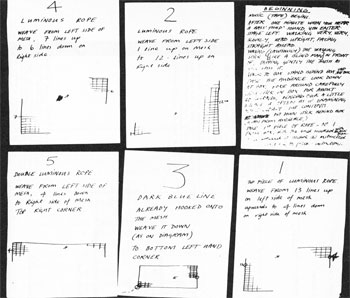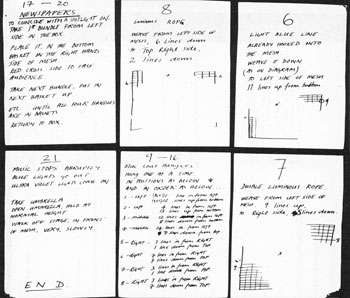DOME
If The Vehicle Is Comfortable, The Road Is Flat.
If The Road Is Flat, Any Vehicle Is Comfortable
Rock Magazine, Japan, May 1981
BIOGRAPHY
B.C. Gilbert
born 1946
was educated
worked
art school
worked
G. Lewis
born 1953
was educated
art school
worked
1976:
Became involved with WIRE project
(with C. Newman / R. Gotobed)
Recorded 3 albums:
PINK FLAG
CHAIRS MISSING
154
plus 6 singles
1979:
People In A Room project,
Jeanette Cochrane Theatre
in conjunction with Central School of Art,
Theatre Department
1980:
In February, WIRE's final project
at Electric Ballroom
RECORDING PROJECTS:
DOME 1 album - released on Dome Label, July 1980, sold by Rough Trade
CUPOL 12" - released on 4AD, August 1980
3R4 album - released on 4AD, December 1980
DOME 2 album - released on Dome Label, February 1981, sold by Rough Trade
|
|
After working in 24-track studios with Wire, the two chose to work in an 8-track studio called
Blackwing Studios.
Here, they were able to persure the use of the studio as a compositional tool,
rather than working in a stricg "song" format. The new engineer was also interested in
exploring the limites of the studio itself and its equipment, and the two found him easy to work with.
Around the time of the CUPOL project, the two started to work with Russell Mills.
They had known Russell since the Wire era and always wanted to work with him, but didn't know
what form it would take.
Russell Mills is an artist, known for his paintings inspired by Brian Eno's music. He had no
knowledge whatsoever of the recording process, but had ideas about what he thought was good/bad
music. He played percussions on the 3R4 album.
|
|
PERFORMANCE:
KLUBA CUPOL
Notre Dame Hall, 19 June, 1980
8PM:
Colsta Del Song
Mike Collins (song) / Bid (guitar)
8:15-8:55PM:
Blurt
9:10-9:30PM:
Nocturna Artificialia
a film by Brothers Quay
9:40-10:00PM:
DOME CUPOL
Music: G. Lewis, B.C. Gilbert
Construction: Russell Mills
Constructor: Shinro Ohtake
Lighting: Mike Buchanan
10:15-11:00PM:
DAF
|
|
Mike Collins is the former Wire Manager (currently he manages
the Monochrome Set, Colin Newman, etc.) He had suggested Notre Dame
as a venue, when Gilbert & Lewis came up with the idea for doing a live show
before going back to the studio to record KLUBA CUPOL.
He sang a 2-minute song, accompanied by Bid (the Monochrome Set) on guitar - a Latin cabaret.
The two knew Ted Milton of Blurt in his previous incarnation as a poet and puppeteer. They liked DAF, a German band, who had played at the last Wire concert. It was Russell's idea to show the Brothers Quay film; they are American poster artists, and this was their first film. They have since produced a poster for the DOME 2 album.
A tape of music for playing between acts were also recorded on the evening before the show.
|
|
|
CUPOL DOME PERFORMANCE
--- all components were as important as the actual piece of music ---
The idea was to produce a 20-minute tape in advance, and to play along and over the tape. No rehearsal took place - chance was more important.
Graham wrote the lyrics on the night before, mainly about the Afghanistan conflict (which was going on at the time.)
Graham, who used to play the bass in Wire, played the guitar; and Bruce, who used to play the guitar in Wire, played the bass this time.
Russell played the synthesizer - he had no previous experience of playing the instrument. He went around to Graham's house and found a noise that he wanted to use: a natural process of discovery.
Graham had made a cassette of noise with his brother, using domestic instruments. Russel was supposed to play this tape, but he forgot to bring it. Furthermore, he forgot the fact he had forgotten the tape, and kept pressing the Play button during the performance, resulting in no sound coming out. Yet it was interesting, as at least one of his hands was away from the keyboards, which he could have been playing instead.
Russell designed a construction, which his Japanese illustrator friend Shinro Ohtake built
during the 20-minute performance. It was a visual analogue of what the music was saying, yet not
so literal as to make the audience think little themselves.
Russel managed to find most of the material he needed cheaply, all things designed for some other purposes.
Shinro Ohtake, who is also in a Japanese band called 19 (Juke), happened to be in the country and was only told the night before that he was going to be performing. He was not told in advance what it was going to be like or what the music was going to be, and therefore was much fresher in his approach than Russell himself could have been with his own construction. The instructions for using the elements to build the whole construction were given to Shinro on the night before, which he translated into Japanese, so that he could read them quickly in the dark.


Russell's instructions to Shinro. (Click to enlarge.)
The original article contained many other illustrations and photographs,
most of which are unfortunately too rough a quality to reproduce here.
Mike Buchanan, a West End lighting engineer and also a friend of Russell's, was excited by the
project - he had never been offered a job like this before - and was happy to help them free of charge.
Because of the economic restrictions, he was forced to utilise the existing lights at Notre Dame, which were in a terrible state: broken, not connected, and so on.
Their lighting needs were simple but very difficult to attain. They told him what they wanted happening; he made alternative suggestions as to what could be made to happen under the circumstances. They let him do what he wanted to do, but within a very tight boundary.
Graham didn't know much about the technical details of the lighting in advance, and at one point during the performance, he couldn't read the lyrics he'd written on a piece of paper - nor had he memorised the lyrics beforehand. This therefore imposed another restriction, which in turn shaped the performance.
LATEST PROJECT:
At present, Gilbert & Lewis are in the studio several
days a month, working on material which will be released
as DOME 3.
Unlike the previous albums that consisted of recordings
made within a previously set period (34 hours in case of
DOME 1, five days for DOME 2), this time they have
not set themselves any time limits. They spend between a
half and a full day on each piece, and will continue working
this way until they have enough material for an album.
(The CUPOL 12" was also recorded this way. As they
generally don't rehearse before going into the studio, this
way some of the studio time can be used for the purpose
instead.)
The material on the attached flexidisc, recorded especially
for this magazine, is also part of the DOME 3 project,
and it's the latest material by this duo available at present.
The track "Cross, Grow, Prayer" will possibly be re-worked
and included on the upcoming album.
(c) Akiko Hada 1981/2020
Back to Interviews Index
|